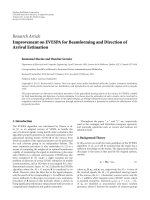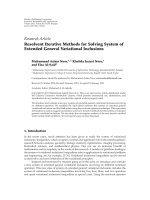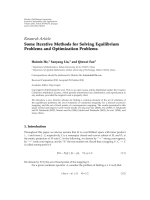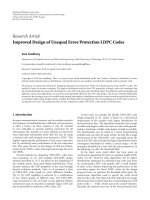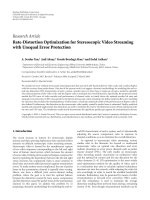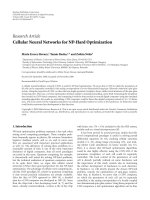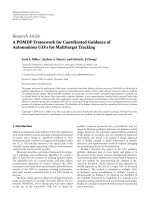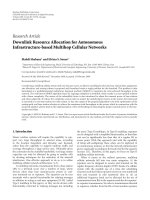Báo cáo hóa học: " Research Article Improved Intra-coding Methods for H.264/AVC" docx
Bạn đang xem bản rút gọn của tài liệu. Xem và tải ngay bản đầy đủ của tài liệu tại đây (780.72 KB, 9 trang )
Hindawi Publishing Corporation
EURASIP Journal on Advances in Signal Processing
Volume 2009, Article ID 328958, 9 pages
doi:10.1155/2009/328958
Research Article
Improved Intra-coding Methods for H.264/AVC
Li Song,
1
Yi Xu,
1
Cong Xiong,
1
and Leonardo Traversoni
2
1
The Institute of Image Communication and Information Processing, Shanghai Jiaotong University, Shanghai 200240, China
2
Divisi
´
on de Ciencias B
´
asicas e Ingenieria, Universidad Aut
´
onoma Metropolitana-Iztapalapa, 09340 M
´
exico, DF, Mexico
Correspondence should be addressed to Li Song, song
Received 2 June 2008; Revised 3 September 2008; Accepted 1 February 2009
Recommended by Liang-Gee Chen
The H.264/AVC design adopts a multidirectional spatial prediction model to reduce spatial redundancy, where neighboring pixels
are used as a prediction for the samples in a data block to be encoded. In this paper, a recursive prediction scheme and an enhanced
(block-matching algorithm BMA) prediction scheme are designed and integrated into the state-of-the-art H.264/AVC framework
to provide a new intra coding model. Extensive experiments demonstrate that the coding efficiency can be on average increased by
0.27 dB with comparison to the performance of the conventional H.264 coding model.
Copyright © 2009 Li Song et al. This is an open access article distributed under the Creative Commons Attribution License, which
permits unrestricted use, distribution, and reproduction in any medium, provided the original work is properly cited.
1. Introduction
H.264/AVC [1] is the newest international video coding stan-
dard of ITU-T (as Recommendation H.264) and ISO/IEC
(as International Standard 14496-10 akin MPEG-4 part 10)
advanced video coding (AVC). It considerably reduces the
bit rate by approximately 30 to 70 percent when compared
with previous video coding standards such as MPEG-4 Part
2, H.263, H.262/MPEG-2 Part 2 and to name a few, while
providing the same or better image quality.
The intracoding algorithm of H.264 exploits the spatial
and spectral correlation present in an image. Intraprediction
removes spatial redundancy between adjacent blocks by
predicting one block from its spatially adjacent causal
neighbors. A choice of coarse and fine intraprediction is
allowed on a block-by-block basis. There are two types of
prediction modes for the luminance samples, that is, the so-
called Intra 4
× 4 mode which predicts each 4 × 4block
independently within a macroblock and the Intra 16
× 16
mode which predicts a 16
×16 macroblock as a whole unit. As
for Intra 4
× 4 mode, nine prediction modes are available for
the encoding procedure, among which one represents a plain
DC prediction and the remaining ones operate as directional
predictors distributed along eight different angles, as shown
in Figure 1.Intra16
× 16 mode is suitable for smooth
image areas, where four directional prediction modes are
provided as well as the separate intraprediction mode for the
chrominance samples of a macroblock.
H.264 achieves excellent compression performance and
complexity characteristics in the intramode even when
compared against the standard image codecs (JPEG and
JPEG2000) [2, 3]. In recent years, extended works have
been developed to further improve the performance of
intraprediction. Gang et al. proposed an intraprediction
method based on subblock, altering the encoding order of
the predictive subblocks so as to make the intraprediction
adaptive to various textures [4]. However, this method needs
to add new syntax elements and as well incurs nonnegligible
complexity. Some authors introduced intramotion compen-
sated prediction of macroblocks [5]. Block size and accuracy
adaptation can be brought into the intra block-matching
scheme to further improve the prediction results. In such a
manner, the position of reference block should be coded into
the bit stream. Thus a lot of extra side information would
affect the performance significantly. To reduce this overhead
information, special processing techniques are developed
and result in a big change of intracoding structure in the
H.264/AVC standard [6]. In [7], block-matching algorithm
(BMA) is utilized to substitute for H.264 DC intraprediction
mode with no need to code side information. However,
prediction performance would be degraded if directly using
previously reconstructed pixels for the matching procedure.
Also, improved lossless intracoding methods are proposed to
substitute for horizontal, vertical, diagonal-down-left (mode
3), diagonal-down-right (mode 4) of H.264/AVC [8, 9].
They employ samplewise differential pulse code modulation
2 EURASIP Journal on Advances in Signal Processing
QA BC DEFG H
I
K
L
abcd
efgh
ijkl
mn o p
J
(a) Samples a–p predicted by
the samples A–L and Q
3
7
0
5
4
6
1
8
(b) Eight predic-
tion directions
Figure 1: Intra 4 × 4 coding mode.
(DPCM) method to conduct prediction of pixels in a target
block. Yet this kind of methods can only be used in lossless
mode.
From the above-mentioned analysis, current-enhanced
intracoding methods still have problems remained, namely,
either changing the coding structures a lot (e.g., [5, 6])
or having limited usage (e.g., [9, 10]) or alternatively less
gain (e.g., [4]). In this paper, we focus on how to improve
the performance of intracoding without incurring high cost
of complexity and major changes for the design struc-
ture of H.264/AVC. Two prediction schemes are advanced
to improve current intracoding performance. In the first
scheme, more neighboring pixels contribute to recursively
predict current pixel inside one block in a samplewise
manner. Consequently, this scheme would match texture
characteristics of the input source with high adaptation and
minor extra complexity as well. The other prediction scheme
is motivated by the fact that loop filter can significantly
enhance the performance of the inter prediction. We propose
to extend the classical BMA method [7] by imposing loop fil-
tering on previously reconstructed macroblocks before BMA
operation. Specifically, we change the orders of standard
deblocking loop filter of H.264/AVC to achieve extra gains
without incurring extra complexity. Extensive experiments
show that intracoding of H.264 can be further improved in
the proposed work for both lossy and lossless case.
The remaining parts of this paper are structured as
follows. Section 2 describes the proposed recursive predic-
tion scheme and the enhanced BMA prediction scheme.
Codec-related issues are discussed in Section 3. Comparison
experiments of the proposed intracoding model and the
standard one in H.264/AVC are shown in Section 4. Finally,
Section 5 concludes the paper.
2. Two Prediction Schemes for
Intracoding of H.264/AVC
In this section, we will explain the improvement mechanism
behind the recursive prediction scheme and the enhanced
BMA prediction scheme. Both schemes join in the prediction
modes of H.264/AVC with good compatibility and comple-
mentary merits. The resultant intracoding model can well
improve the overall performance of H.264/AVC.
2.1. Mechanism of Recursive Prediction Scheme. It is generally
accepted that Gaussian-like distribution could approximate
the local intensity variations in smooth image regions. The
correlation between neighboring pixels would be attenuated
while the distance is increasing and negligible when pixels
are far enough apart. Furthermore, the assumption of
the Gaussian distribution would become weak around the
irregular texture areas and edge structures. The current
prediction methods of H.264/AVC take an assumption that
the intensity is uniform within the block to be predicted.
Thus over-smoothness would be induced to the target
block after prediction. As a result, the original intensity
distribution is more or less destroyed. Especially for those
natural images with abundant textures, the perception
distortions are distinct. In all cases, high correlation can be
expected among the nearest neighbors spaced one pixel apart
except those within the image structures thinner than one
pixel.
Given a 4
× 4 luma block to be coded as shown
in Figure 2(a), namely, the sequence of pixels from a–p,
the mechanism of standard prediction mode and recursive
prediction mode can then be, respectively, illustrated in
Figures 2(b) and 2(c). Here we use gray color to mark the
reference pixels, that is, the pixel set S
= {A, B, C, D, Q,
I, J, K, L
}. Then pixels a–p will be predicted from these
reference pixels. Now we explain the prediction procedure of
pixels a, f, k, p referring to Figure 2. In standard prediction
mode, these four pixels would take the same value which is
deduced from reference pixels A, Q,andI. Residuals might
have large values if the assumption of uniform intensity is
violated. Alternatively, we select different reference pixels
to recursively predict the value of a, f, k,andp. Only the
left, the top, and the left-top pixels are actively involved in
computing the center pixel value. Therefore the contribution
of neighboring pixels is gradually decayed with distance
increasing during the recursive prediction. The textures
within the block would be retained, which results in smaller
residual deviations.
In block-based H.264/AVC, we cannot obtain reconstruc-
tion of pixels inside current coding block except lossless case,
where the reconstructed frame is identical to the original
frame. In fact, only predicted value of neighboring pixels
obtained in previous step is used to predict current pixel in
our method. That is, it recursively predict each pixel inside
block in the raster scan order.
Furthermore, we emphasize two facets in the imple-
mentation of the proposed recursive prediction method. On
one hand, no modification should be imposed on the other
parts of the design structure of H.264/AVC, besides part
of intraprediction module. Specifically, we only change the
five modes of H.264/AVC intraprediction module, among
which are DDR mode (mode 4), HD mode (mode 5),
VR mode (mode 6) for 4
× 4 luma blocks, plane mode
(mode 3) for 16
× 16 luma blocks, and plane mode
(mode3)forchromablock.Thesefivemodescaneasily
support prediction neighborhood of our method. On the
other hand, we would expect to find the tradeoff between
the complexity and efficiency of the whole intracoding
procedure.
For convenience in representation, we denote current
pixel value as p, where (x, y) is the spatial position within
the block, for example, (0, 0) indicates the left-top pixel. As
EURASIP Journal on Advances in Signal Processing 3
QA B CD
I
K
L
a
b
cd
e
f
gh
ijkl
mn o p
J
(a) 4 × 4 luma block to be coded
QA
A
Q
QA
Q
A
I
I
I
I
a
f
k
p
(b) Standard prediction mode
Q
A
I
a
ab
f
e
f
g
k
j
kl
po
(c) Recursive prediction
mode
Figure 2: Comparison between recursive prediction mode and standard prediction mode.
A
2
A
1
A
0
X
Figure 3: The tap filter of recursive prediction.
Table 1: The tap filters corresponding to the five-modified
prediction modes.
New mode
Ta p fi lter c oefficients (x, y)
A
0
A
1
A
2
0∼3, 0∼3
4 × 4 DDR 1 2 1 0∼3, 0∼3
4
× 4VR 3 −12 0∼3, 0∼3
4
× 4HD 2 −130∼15, 0∼15
16
× 16 PLANE 5 −25 0∼7, 0∼7
Choma PLANE 5
−25 0∼3, 0∼3
shown in Figure 3, the value of the predicted pixel can be
computed from
p(x, y)
= Clip
Round
A
0
× p(x − 1, y)+A
1
× p(x, y − 1)
+ A
2
× p(x − 1, y − 1)
,
(1)
where Round(
·) is the numerical operation that returns the
closest integer to “
·,” Clip(·) is another numerical operation
which clamps the predicted value to the range of [0, 255].
The tap filter coefficients corresponding to the five-modified
prediction modes, which are gotten from experiments, are
listed in Tab le 1.
2.2. The Mechanism of Enhanced BMA Intraprediction
Scheme. Block matching is originally used in image restora-
tion task to recover missing blocks [11]. The main assump-
tion behind this application is that one block always has
similar counterparts in the same frame. Yang et al. [7]
integrated block-matching algorithm into DC mode of
P
9
X
P
1
P
2
P
3
P
4
P
5
P
6
P
7
P
8
(a) Matching primitives for
block X
M
X
(b) Valid search range for 4 × 4
block prediction
Figure 4: BMA prediction mode.
H.264/AVC standard prediction methods and generated an
outcome of BMA mode for intraprediction. As coding is a
sequential execution, one only can use the upper side, the left
side, and the left up side of the boundary to perform block-
matching, that is, the pixel set consisting of p
1
–p
9
around
block “X,” asdepicted in Figure 4(a). The green block “M”
in Figure 4(b) is the candidate block while the blue block
“X” is the block to be predicted. The black pixels along the
boundary are selected as the matching primitives. The valid
search range is marked as the gray region. The matching
process is formulated as the minimization of the following
cost function:
MSE
=
9
i=1
p
i
− p
i
2
,(2)
where p
i
and p
i
, respectively, represent the pixel values
within block “X”andblock“M.”
It is noted that original DC mode should be still used
when the upper or left side is not available for the block to
be predicted. Similar to the encoder, the decoder also needs
to do block-matching.
The BMA prediction method has been proved as a good
means to achieve gains in some video sequences [7], whereas
there are still two open problems. BMA is accurate in high
bitrates encoding case but not much good in low bitrate.
The main reason is that the candidate macroblocks have not
yet been passed to the loop filter, thus the best matches and
the residuals would be greatly affected by the conspicuous
4 EURASIP Journal on Advances in Signal Processing
M
3
M
0
M
2
M
1
0145
2367
8 912
10 11
Figure 5: Candidate matches for a 4×4 luma block in the enhanced
BMA intraprediction scheme.
blocking artifacts. Especially when the best match spans two
or more encoding macroblocks, it might be considered as a
false match or the prediction residuals would increase sharply
due to the blocking artifact. In addition, only the upper side,
left side, and left up side pixels along the boundary of the
block contribute to the block-matching results. The limited
number of primitives would result in high ambiguities in the
matching process. It is important to rationally reduce the
solution space to a more restricted one.
To alleviate the ill-effects incurred by blocking artifacts,
we put the loop filtering at the rear of BMA intracoding step
for each macroblock rather than perform it after the whole
slice has already been coded. Thus all the previously coded
macroblocks are well deblocked and provide more correct
details for the subsequent blocks to find a good match. The
prediction error propagation through all the macroblocks is
then well controlled. The good compatibility with standard
H.264/AVC can be expected since we only change the order
of loop filtering step in the whole functional structure but
not change the loop filtering itself. Also no extra complexity
is induced by this improvement.
To further reduce the ambiguities involved in matching,
we constrain the search space to a more restricted one than
that in the original BMA method, as shown in Figure 5,
only the left macroblock “M
1
,” the left-top macroblock “M
3
,”
the top macroblock “M
0
,” the right-top macroblock “M
2
,”
and those blocks numbered from 0–11 predicted ahead are
considered as the candidate match of the current 4
× 4
luma block 12. Our extensive experiments proved that in
most cases the globally optimal match can be captured by
neighboring candidates M
0
–M
3
. It should be noted that
macroblocks M
0
–M
3
have been loop filtered but the luma
blocks 0–11 are not involved in deblocking before the
current macroblock has been wholly predicted. Considering
the compatibility with standard H.264/AVC, we restrict the
search space to M
0
–M
3
.
3. Codec-Related Issues
We hybridize the two proposed schemes into an H.264/AVC
functional structure as the new modes for intraprediction.
For purpose of easy implementation and bit savings, we
substitute mode, 4, 5, 6 of 4
× 4 luma prediction, mode 3
of 16
× 16 luma prediction, and 8 × 8 chroma prediction
with corresponding recursive prediction mode. In addition,
we replace mode 2 (which is DC mode in intraprediction
for 4
× 4 blocks) with the enhanced BMA prediction
mode without concern over those blocks on the upper or
left frame boundary. Such a combination depends on the
complementary properties of the two proposed schemes,
which would be discussed in Section 4.
The encoder uses the new modes along with the other
preserved modes to perform prediction for 4
× 4, 16 × 16,
and 8
× 8 blocks. Among these prediction modes, the mode
with the lowest rate-distortion cost would be selected as the
optimal mode for prediction. Since there is no extra mode
introduced, the syntax of the original standard of H.264/AVC
remains unchanged. Only semantic or decoding processing
needs to be modified correspondingly.
On the decoder part, we can directly perform the
operations similar to those at the encoder for recursive
prediction. As for mode 2, we first check whether the
block is located at the upper or the left boundary of
the frame. If so, we decode it using normal DC mode.
Otherwise, we decode it using enhanced BMA intrapredic-
tion mode. Before decoding one block in enhanced BMA
mode, loop filter is imposed on the nearest neighboring
macroblocks to alleviate blocking effects, as shown in
Figure 5. Afterward, the decoder runs a block search in
the current frame. The best match would be utilized for
prediction.
4. Experimental Results
To characterize the performance of two proposed prediction
schemes, we select a variety of video sequences to execute the
intracoding tests. Here we provide comparison experiments
to evaluate the performance of five intracoding prediction
schemes. Besides the proposed recursive intraprediction
scheme (R scheme) and enhanced BMA intraprediction
scheme (E-BMA scheme), the standard intraprediction
scheme in H.264/AVC (S scheme) [1], the original BMA
intracoding scheme (BMA scheme) [7], and the hybrid
intraprediction scheme (H scheme) combined the two
proposed methods are testified in terms of computational
complexity, lossless compression, and variable bitrate. The
baseline work is referred to the open H.264/AVC codec
rev602 [12].
At first, we provide the common configuration param-
eters in the tests. Frame rate is set at 30 Hz. The total
number of the encoded frames is 100 for each test sequence.
Hadamard transform is enforced on these video frames. 8
×8
transform is not chosen. As for the entropy coding, the
CAVLC (context-based adaptive variable length coding) is
used for the experiment, RDO is enabled and all I frames
of video are encoded as intraframe with different QP (QP
= 0 for lossless). As for other typical settings such as
CABAC entropy coding, RDO disabled, rate control enabled,
experiments consistently show similar gains of our proposed
scheme. In the following experiments, we regard S scheme as
the anchor and analyze the relative performance of the other
four counterparts.
EURASIP Journal on Advances in Signal Processing 5
Table 2: Computational complexity analysis of R scheme.
Mode Operation 4 × 4 DDR 4 × 4VR 4× 4HD 16× 16 plane Chrome plane
Sscheme
ADD/SUB 45 58 58 1229 347
MUL/DIV 30 36 36 789 203
Rscheme
ADD/SUB 64 64 64 1024 256
MUL/DIV 16 32 32 768 192
Table 3: The bitrate saved by E-BMA scheme, R scheme, and H scheme.
Sequence
Resolution
ΔB(%)
E-BMA scheme R scheme H scheme
QCIF
Bus
0.40 0.18 0.73
Carphone
1.30 0.09 1.49
City
0.21 0.65 0.97
Crew
0.05 0.37 0.55
Football
0.10 0.37 0.64
Foreman
1.92 −0.83 1.92
Harbor
0.17 0.47 0.78
Ice
0.44 0.00 0.56
Mobile
0.18 −0.07 0.21
Soccer
0.11 0.24 0.49
CIFb
Bridge
0.19 0.08 0.40
Bus
0.61 0.28 1.04
City
1.65 0.66 2.35
Coastguard
0.26 0.52 0.89
Crew
0.02 0.26 0.37
Flower
0.08 −0.15 0.09
Football
0.38 0.54 1.13
Foreman
1.01 −0.51 1.09
Harbor
0.37 0.64 1.14
Highway
0.62 −0.22 0.62
Ice
0.52 0.09 0.70
Mobile
0.53 −0.31 0.42
News
0.77 −0.03 0.86
Paris
0.70 −0.20 0.75
Soccer
0.22 0.39 0.76
Stefan
0.44 0.26 0.84
Te m p e t e
0.25 0.32 0.70
Waterf all
0.02 0.40 0.65
4CIF
City
2.08 0.84 2.94
Crew
0.06 0.44 0.64
Harbor
0.69 0.96 1.74
Ice
0.37 0.25 0.74
Soccer
0.42 0.72 1.28
HD
City
1.26 1.27 2.31
Harbor
0.70 1.18 1.97
Average ΔB 0.55 0.29 1.00
6 EURASIP Journal on Advances in Signal Processing
Table 4: Video quality assessment of BMA scheme, E-BMA scheme, R scheme, and H scheme.
Sequence
Resolution
ΔPSNR(dB)
BMA scheme E-BMA scheme R scheme H scheme
QCIF
Bus
0.01 0.05 0.08 0.14
Car-phone
0.17 0.47 0.01 0.47
City
−0.01 0.07 0.11 0.18
Crew
−0.02 0.20 0.08 0.27
Football
−0.01 0.07 0.06 0.13
Foreman
0.40 0.60 −0.19 0.49
Harbor
−0.02 0.08 0.14 0.21
Ice
0.06 0.27 0.02 0.29
Mobile
0.01 0.05 0.03 0.09
Soccer
−0.02 0.05 0.05 0.09
CIF
Bridge
−0.01 0.05 0.05 0.09
Bus
0.05 0.09 0.14 0.22
City
0.20 0.30 0.13 0.41
Coastguard
−0.01 0.00 0.12 0.11
Crew
−0.01 0.22 0.05 0.26
Flower
0.00 0.03 0.07 0.12
Football
0.01 0.16 0.12 0.27
Foreman
0.22 0.45 −0.17 0.35
Harbor
0.01 0.14 0.16 0.29
Highway
0.22 0.46 −0.08 0.41
Ice
0.10 0.29 0.00 0.30
Mobile
0.07 0.13 0.02 0.16
News
0.13 0.35 0.05 0.39
Paris
0.09 0.30 0.02 0.35
Soccer
0.00 0.08 0.07 0.15
Stefan
0.04 0.16 0.17 0.34
Te m p e t e
0.00 0.14 0.13 0.27
Waterf all
−0.03 0.01 0.13 0.13
4CIF
City
0.21 0.33 0.21 0.51
Crew
−0.01 0.18 0.06 0.23
Harbor
0.03 0.25 0.24 0.47
Ice
0.11 0.30 0.00 0.32
Soccer
0.01 0.11 0.15 0.24
HD City 0.02 0.15 0.17 0.28
Harbor
−0.04 0.23 0.22 0.33
Averaged ΔPSNR 0.06 0.19 0.07 0.27
4.1. Experiment I: Performance Evaluation with Respect to
Computational Complexity. The computational complexity
of R scheme can be easily calculated. The anchor compu-
tation of standard H.264/AVC corresponding modes can be
referred to [13]. In the case of DDR mode (diagonal down
right) of Intra 4
×4 prediction, the pixels from a–p in Figure 1
are predicted from the uniform formulation (I + 2Q + A +
2)/4 as referred to formula (1) and the tap filters designated
in Tab le 1. It needs 3 addition operations, 1 multiplication
(bitwise left shift) operation and 1 division (bitwise right
shift) operation to calculate the prediction sample. However,
we can replace some multiplication operations with addition,
for example, using Q + Q instead of 2
× Q. So we only need
four times additions and one division operations for one
pixel. Besides DDR mode, the other modes can be computed
in the similar way.
Ta ble 2 presents the computational complexity analysis
of recursive prediction relative to the normal mode in
H.264/AVC (S scheme), which is obtained by counting
addition/subtraction and multiplication/division for corre-
sponding 4
× 4, 16 × 16, or chrome block. The difference
of computational complexity between BMA scheme and E-
BMA scheme mainly depends on the search range selected
in both schemes since two computational structures are
EURASIP Journal on Advances in Signal Processing 7
equal except the loop filtering order. Thus E-BMA can be
expected with lower computational complexity than BMA
scheme because of a narrower search range. Compared
with S scheme, the increased complexity is high because
of the additional block-matching step. The computational
complexity in the encoder is similar to that of motion
estimation, using a 9-pixel template inside the search region.
Therefore the order of complexity in the encoder is similar to
that of P-slice. In Figure 5, we need 748 times computation
(formula (2)) and comparison for every 4
×4 block with full-
pixel block-matching in our current implementation, which
makes both encoder and decoder 5
∼8 times slower than
standard H.264/AVC intraprediction.
It seems such high computational complexity will offset
benefits of E-BMA scheme. However, fast search techniques
similar to fast motion estimation in inter prediction and
parallel algorithms can be employed in block-matching to
greatly speed up our current full-pixel procedure. Such
accelerated methods are out of the scope of this paper, but
we conjecture complexity of H scheme which integrate R and
EBMA scheme should be something between intra-(I slice)
and inter prediction(P slice). Therefore, the complexity issue
of proposed hybrid intramode is not so serious when used
with inter prediction (P or B slice).
In the decoder, the increase of computational complexity
depends on the number of the blocks that use this mode. In
sequences where the E-BMA mode really helps in the coding
efficiency,thismodeisselectedintheorderof15%
∼35%
of the blocks. In sequences where the E-BMA mode is
not selected, the additional computational complexity is
negligible.
4.2. Experiment II: Performance Evaluation with Respect to
Lossless Compression. As analyzed in experiment I, the dif-
ference between BMA scheme and E-BMA scheme depends
on two facets, namely, the order of loop filtering step in the
whole functional structure and the search range of the best
match to output the prediction residuals. Since the search
range is a kind of parameter setting problem, the main
difference related to the fundamental mechanism exists in
the loop filtering order. However, there is no loop filtering
adopted in the H.264/AVC video coding standard under
the lossless compression case. Therefore the BMA scheme
and the E-BMA scheme would be expected with similar
performance evaluation with regard to lossless compression.
According to (3), we list in Ta bl e 3 the bitrate saved by E-
BMA scheme, R scheme, and H scheme when compared to S
scheme in a varied corpus of YUV video sequences recorded
at QCIF, CIF, 4CIF, and HD resolutions,
ΔB
=
B
s
− B
x
B
s
× 100%. (3)
In the above formulation, B
x
denotes the bitrate required in
the given scheme while B
s
represents the anchor one required
in S scheme.
From the above analysis in Tabl e 3, it is shown that the
bitrate is positively reduced in E-BMA scheme for lossless
compression of all the test video sequences. As for R scheme,
the bitrate is somewhat oscillatory with negative reduction
in a few sequences which have more local directional smooth
structures (e.g., background of “foreman”). The pixelwise
recursive prediction is not effective in these areas. As a
hybrid combination of E-BMA scheme and R scheme, H
scheme achieves the highest bitrate savings with the average
reduction of 1%. In general, the test sequences are coded at
a slightly lower bitrate in E-BMA scheme, R scheme, and
H scheme as compared to S scheme for achieving lossless
quality.
4.3. Experiment III: Performance Evaluation with Respect to
Variable Bitrate. To cover a wide range of bitrates, we choose
the QP values among 16, 20, 24, 28, 32, and 36. Thus the
performance of the prediction schemes could be evaluated
from high bitrate to low bitrate. Here PSNR tool is used
to measure video quality under varied prediction schemes.
Given PSNR measurement of S scheme, we define the PSNR
gain of the other schemes as
ΔPSNR
= PSNR
x
− PSNR
s
,(4)
where PSNR
x
denotes the peak signal-to-noise ratio acquired
in the given scheme while PSNR
s
represents the reference one
acquired in S scheme. Similar to the calculation in [14], the
outputs of ΔPSNR are averaged for all the QP options (16
∼
36)andlistedinTab le 4.
BMA scheme shows its advantages in a few video
sequences, such as “Foreman,” “City,” and “Highway.” How-
ever, no distinct improvements can be observed in the major
part of the test sequences. Even degradation is introduced to
some sequences as the blocking artifact increases the cost of
(2). In contrast, the proposed E-BMA scheme improves the
video quality by 0.2 dB on average. As for the proposed R
scheme, half of the sequences are improved by over 0.1 dB
in quality. A few sequences are somehow degraded while
using R scheme, such as “Foreman” and “Highway” (the
possible reason has been explained in Section 4.2). As the
hybrid scheme between E-BMA and R, H scheme presents
its promising performance in all the cases. We even can
get 0.35 dB improvement in some sequences, for example,
“Carphone,” “Foreman,” “City,” and “Harbor.” The main
reason of such a positive evolution can be found in the
complementary properties of E-BMA scheme and R scheme.
In our experiments, it is shown that E-BMA has better
performance under low bitrates in that block-matching is
well known for its good performance in smooth regions. On
the contrary, R scheme is motivated to preserve the textures
within the block, which shows more promising performance
under high bitrates. Also the video contents would affect the
performance of these two schemes due to the distribution
of smooth regions and nonsmooth regions. For example, R
scheme achieves the higher prediction accuracy as in those
sequences like “Carphone,” “Crew,” “Ice,” “Foreman,” and
“Paris.” But it runs in the opposite way as in the sequences
like “Bus,” “Coastguard,” and “Waterfall.”
Furthermore, we use three rate distortion (RD) curves
to demonstrate the improvement induced by the hybrid
combination of E-BMA scheme and R scheme, respectively,
8 EURASIP Journal on Advances in Signal Processing
30
32
34
36
38
40
42
44
46
48
PSNR (dB)
210 510 810 1110 1410 1710
Bitrate (kbps)
Sscheme
Hscheme
Figure 6: RD curves of encoding Carphone (QCIF) sequence with
S scheme and H scheme.
28
30
32
34
36
38
40
42
44
46
PSNR (dB)
980 2980 4980 6980 8980 10980
Bitrate (kbps)
Sscheme
Hscheme
Figure 7: RD curves of encoding City (CIF) sequence with S scheme
and H scheme.
for three sequences recorded at different resolutions, that is,
“Carphone,” “City,” and “Harbor,” as illustrated in Figures 6,
7,and8.
5. Conclusion
In this paper, we propose two schemes to further improve
the performance of intraprediction in H.264/AVC. The new
modes developed by these schemes replace the classical
direction prediction modes of H.264. The experimental
results demonstrate that our schemes could improve the
overall performance of compressed I frame by 0.1
∼0.47 dB
as compared to the H.264/AVC standard. In addition, our
schemes have high compatibility with many existing predic-
tion methods. However, for video sequences with directional
structures, recursive prediction degrades its performance a
little. In our future research, we will explore more complex
context to improve its performance of prediction. As for E-
BMA, further gains can also be expected if we introduce
adaptive template and extend our block-matching to the
subpixel accuracy case.
29
31
33
35
37
39
41
43
45
47
PSNR (dB)
3500 8500 13500 18500 23500 28500
Bitrate (kbps)
Sscheme
Hscheme
Figure 8: RD curves of encoding Harbor (4CIF) sequence with S
scheme and H scheme.
Acknowledgments
This work was supported by National Natural Science Foun-
dation of China (60702044 and 60632040) and Research
Fund for the Doctoral Program of Higher Education of
China (200802481006).
References
[1] ITU-T Recommendation H.264 and ISO/IEC 14496-10,
“Advanced video coding for generic audiovisual services,” May
2003.
[2] D. Marpe, V. George, H. L. Cycon, and K. U. Barthel, “Perfor-
mance evaluation of Motion-JPEG2000 in comparison with
H.264/AVC operated in pure intra coding mode,” in Wavelet
Applications in Industrial Processing, vol. 5266 of Proceedings of
SPIE, pp. 129–137, Providence, RI, USA, October 2003.
[3] A. Al, B. P. Rao, S. S. Kudva, S. Babu, D. Sumam, and A. V. Rao,
“Quality and complexity comparison of H.264 intra mode
with JPEG2000 and JPEG,” in Proceedings of the International
Conference on Image Processing (ICIP ’04), vol. 1, pp. 525–528,
Singapore, October 2004.
[4] Z. Gang, G. Li, and Y. He, “The intra prediction based on sub
block,” in Proceedings of the 7th International Conference on
Signal Processing Proceedings (ICSP ’04), vol. 1, pp. 467–469,
Beijing, China, August-September 2004.
[5] Joint Video Team (JVT) of ISO/IEC MPEG and ITU-T
VCEG, “New intra prediction using intra-macroblock motion
compensation,” in Proceedings of the 3rd JVT Meeting, Fairfax,
Va, USA, May 2002, JVT-C151.
[6] K. L. Tang and K. N. Ngan, “Enhancement techniques for
intra block matching,” in Proceedings of IEEE International
Conference on Multimedia and Expo (ICME ’07), pp. 420–423,
Beijing, China, July 2007.
[7] J. Yang, B. Yin, and N. Zhang, “A block-matching based
intra frame prediction for H.264/AVC,” in Proceedings of IEEE
International Conference on Multimedia and Expo (ICME ’06),
pp. 705–708, Toronto, Canada, July 2006.
[8] Y L. Lee, K H. Han, and G. J. Sullivan, “Improved lossless
intra coding for H.264/MPEG-4 AVC,” IEEE Transactions on
Image Processing, vol. 15, no. 9, pp. 2610–2615, 2006.
EURASIP Journal on Advances in Signal Processing 9
[9] S. Takamura and Y. Yashima, “H.264-based lossless video
coding using adaptive transforms,” in Proceedings of IEEE
International Conference on Acoustics, Speech, and Signal
Processing (ICASSP ’05), vol. 2, pp. 301–304, Philadelphia, Pa,
USA, March 2005.
[10] A. Robert, I. Amonou, and B. Pesquet-Popescu, “Improving
intra mode coding in H.264/AVC through block oriented
transforms,” in Proceedings of the 8th IEEE Workshop on
Multimedia Signal Processing (MMSP ’06), pp. 382–386,
Victoria, Canada, October 2006.
[11] Z. Wang, Y. Yu, and D. Zhang, “Best neighborhood matching:
an information loss restoration technique for block-based
image coding systems,” IEEE Transactions on Image Processing,
vol. 7, no. 7, pp. 1056–1061, 1998.
[12] “x264—a free H.264/AVC encoder,” />developers/x264.html.
[13] Y L. Lee and K H. Han, “Complexity of the proposed lossless
intra for 4:4:4,” JVT-Q035, October 2005.
[14] G. Bjontegaard, “Calculation of average PSNR differences
between RD-curves,” in Proceedings of the ITU-T VCEG 13th
Meeting, Austin, Tex, USA, April 2001, VCEG-M33.
